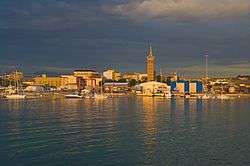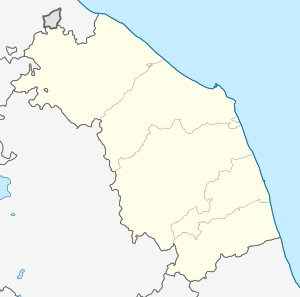Civitanova Marche
| Civitanova Marche | ||
|---|---|---|
| Comune | ||
| Comune di Civitanova Marche | ||
 View of the port of Civitanova Marche. | ||
| ||
.svg.png) Civitanova within the Province of Macerata | ||
 Civitanova Marche Location of Civitanova Marche in Marche  Civitanova Marche Civitanova Marche (Italy) | ||
| Coordinates: 43°18′N 13°44′E / 43.300°N 13.733°ECoordinates: 43°18′N 13°44′E / 43.300°N 13.733°E | ||
| Country | Italy | |
| Region | Marche | |
| Province | Macerata (MC) | |
| Frazioni | Civitanova Alta, Fontespina, Maranello, Risorgimento, San Marone, Santa Maria Apparente | |
| Government | ||
| • Mayor | Fabrizio Ciarapica (Vince Civitanova) | |
| Area | ||
| • Total | 45.8 km2 (17.7 sq mi) | |
| Elevation | 3 m (10 ft) | |
| Population (12 March 2017)[1] | ||
| • Total | 42,251 | |
| • Density | 920/km2 (2,400/sq mi) | |
| Demonym(s) | Civitanovesi | |
| Time zone | UTC+1 (CET) | |
| • Summer (DST) | UTC+2 (CEST) | |
| Postal code | 62012 | |
| Dialing code | 0733 | |
| Patron saint | San Marone | |
| Saint day | August 18 | |
| Website | Official website | |
Civitanova Marche is a comune (municipality) in the Province of Macerata in the Italian region Marche, located about 40 kilometres (25 miles) southeast of Ancona and about 25 km (16 mi) east of Macerata.
Geography
Civitanova Marche borders the municipalities: Montecosaro, Porto Sant'Elpidio, Potenza Picena and Sant'Elpidio a Mare.[2] It counts the hamlets (frazioni) of Civitanova Alta, Fontespina, Maranello, Risorgimento, San Marone and Santa Maria Apparente.
Territory
The territory is heterogeneous. At south, indicatively for Risorgimento, Centro e Santa Maria Apparente hamlets the city lays on the Chienti river floodplain, formed in Holocene. Along the coast, Centro, Fontespina and San Gabriele hamlets partially lay on sediments of coastal plain.
The area size is 46,07 km² and has coastal hill shape, the altitude level stands between 3 and 223 m.a.s.l. in Contrada San Savino. The typical "a pettine" shape that distinguishes Marche hills is recognizable by the opposition of Valle del Chienti with the hill group where Civitanova Alta lays, that sweetly downgrades to the sea along the suggestive Palazzaccio road, with and altitude of 100 m a.s.l.
Climate
According to the climatic averages between 1971-2000, the average temperatures of the coldest month, January, is +5,3 °C, while in the hottest month, August, it is +22,6 °C.
The annual average precipitation is about 740 mm, with a relative minimum in spring and a maximum in fall.
Annual average relative humidity is 76%, with a minimum of 71% in July and a maximum of 82% in November.
History
Ancient Age
Prehistorical settlements discovered by archaeologists show us that people used to live in Civitanova since Palaeolithic. Civitanova was founded probably around the 8th century BC as Cluana by the Piceni Italic tribe, at the mouth of the Chienti river. The Romans captured it in 268 BC, and, in 50 AD, founded a new settlement, Cluentis Vicus (the current frazione of Civitanova Alta) on a hill near the sea. During the Barbaric invasion, old Cluana was destroyed by the Visigoths and much of the population took refuge in the Vicus.
Middle Ages
Cluentis Vicus succeeds to survive during the Middle Ages and it is mentioned in 1009 as Civitate Nova, Civitas Nova, Civitatem Novam e Nova Civitas. People go live near the coast, on the San Marone hill, where you can find a "Memoria" dedicated to the martyr San Marone protector of Civitanova.
With the arrive of the Franks Cluentis Vicus becomes feudal town. The ancient Aldonesi family (or Aldonensi) in 1075 guarantee, with the bishop of Fermo Pietro I the defense of the city. The it was under the da Varano, Malatesta, Sforza and Visconti.
Modern Age
In 1440, under Francesco Sforza, a new line of walls was built (denominated "Scarpata"), while a fortress was erected to protect the port (the current communal palace "Cesarini-Sforza" has been built upon its remain). The city, attacked by Turk pirates and struck by inner feuds and by the plague, started to decay from the 16th century.
In 1551 pope Julius III (born Grottammare, not far from Civitanova) nominates Cesarini as Duke, that in 1674 gets the name Cesarini–Sforza, following the marriage between Livia Cesarini and Federico Sforza of Santa Fiora. This event signs a period of renaissance and urban renovation: new wall for the "Città Alta" are built suchs as new roads and palaces. Anyway, this doesn't bring any good to the citizens which continue to live in miserable lives. Among the dukes of Civitanova Virginio Cesarini is to be remembered, Italian poet, friend of Galileo Galilei and member of the Accademia dei Lincei.
During the XVII° and the XVIII° centuries, the "Città Alta" gets renovated, the main square gets ampliated and the church of San Paolo gets built, taking the place of the collegiate of the same name, the civic tower gets substituted by the clock tower.
The port gets bigger and gives place to another small town. In 1782 Civitanova hosts 6057 inhabitants whom 5717 in "Città Alta", while 65 in San Marone and 275 at the port.
Contemporary Age
On 12 December 1828, pope Leo XII concedes the title of City to the two towns, Civitanova Alta and Civitanova Porto. In 1833 the city counts 8.400 inhabitants.
In 1841 the first church, Saint Paul, gets built in the port and completed in 1853.
In 1913 the fraction of Civitanova Porto gets elevated to independent municipal and in 1938 Civitanova Porto e Civitanova Alta become as one with the name of Civitanova Marche.
The following industrial development transforms Civitanova Porto in a location of summer resorts lived by the noble families of the hinterland. Count Pieralberto Conti (1923) builds a racecourse and, in 1910, a house in liberty stile financed by his first wife, Countess Augusta Morrone Mozzi.
The city develops itself with new roads, houses, building in libery stile, beaches and ricreative places that gave Civitanova the configuration of a renowned vacation centre.
Civitanova was diocesan centre. According to the Catholic Church tradition the title of the suppressed diocesies is given to the bishops destined at diocesan administrations or diplomatic functions. Today, the owner of the ancient diocese is Arch Bishop Claudio Maria Celli.
Main sights.
Ducal Palace (Palazzo Cesarini-Sforza)
The Ducal Palace Cesarini Sforza was built circa 1550 atop the base of a pre-existing building. Construction started about a year prior to the cession of Civitanova by Pope Julius III to the Roman noble Giuliano Cesarini in payment for a debt contracted by the Apostolic Camera. The interior conserves some 16th-century frescoes by Pellegrino Tibaldi. In 1674, the palace acquired the Sforza label, when Livia Cesarini married Federico Sforza of Santa Fiora. The palace was refurbished in the 19th century; and restored recently. It is situated in Piazza della Libertà of Civitanova Alta.
Palazzo Cesarini-Sforza (Civitanova Porto)
Palazzo Cesarini-Sforza was built in 1862 upon the remains of a 15th-century fortress. The Palace overlooks "Piazza XX Settembre" gardens which conserve the fountain that once decorated the centre of the square.
Palazzo della Delegazione
Built in 1867 according to the project of engineer Guglielmo Prosperi and realized by the Basile brothers, it has three floors oriented towards the square of Civitanova Alta. Ground floor, characterized by a loggia with the ingress at the centre, hosts the Roman gravestone where ancient Civitanova name Cluentensis Vicus is carved. Wide stairs lead to the board room frescoed with Aeneid depictions dedicated to the poet Annibal Caro as well as portraits of noble citizens.
Lido Cluana
Over the gardens of Piazza XX Settembre there are the elegant liberty buildings of Lido Cluana, reworked during the fascist period with the add of fascist flagpoles that can be observed even today.
Villa Conti
Villa Conti is a liberty villa built in 1910, completely destroyed during World War II and consequently rebuilt. Located between Civitanova Alta and Civitanova Porto, characterized by a park with an Italian garden. Next to the villa there is a neo-gothic church which is the reproduction of Cappuccini Nuovi of Macerata. In the crypt of San Micheal Arch Angel Church there are the tombs of counts Conti as well as the tomb of the lirical singer Francisca Solari, second wife of Pier Alberto Conti.
On the property, there is a 15th-century tower and the San Micheal luxury palace, rare example of art nouveau on the Macerata provence. The luxury palace is perfectly conserved and it's built according to architect Paolo Sironi project.
Villa Eugenia
Villa Eugenia is located on San Marone hamlet, commissioned by Napoleon I in 1797. The villa is currently in miserable conditions, and because of this it can't be visited by anyone. Empress Eugenia Montjo, wife of Napoleon III used to live there.
15th century walls
Perfectly conserved, these walls are a good example of military reinessance architecture. Commissioned in 1440 by the Sforza family along with the four S.Paolo, Girone, Mercato and S.Angelo doors.
Sanctuary of San Marone
The church is located on San Marone hamlet, in the lower part of the city. Originally in Romanesque style, erected on the location of the protector martyr. The sanctuary has a central naive as well as two lateral ones and conserves ancient architectural remains; the façade has a lunette in the main gate where there is the depiction of the Virgin with Child between San Marone and Santa Domitilla, work realized at the end of the 19th century by Sigismondo Nardi. The remains of the saint are conserved under the altar. In this sanctuary, the 13 May 1823, Sante Possenti, governor of the Papal States and Agnese Frisciotti of Civitanova got married.
Saint Augustine Church
The original structure of the church belongs to the XIII° century. During the 18th century the church has been reworked and entitled to Saint Augustine. The restructuration has allowed the construction of the dome at the centre of the transept and the new chapels with altars along the naive.
Saint Francis Church
The church, erected during the 14th century and reworked during the 18th century, the original structure conserves the gothic portal, remains of the romanesque-gothic decotarion of the sides and the bell tower. Currently it is used as a multimedia space, for conferences and exhibitions.
Collegiate Church of Saint Paul Apostle
Saint Paul Apostle Church has been built during the 17th century, and had been already a collegiate church. On the inside of the church there are: a font dated 1423 related according to the tradition to San Marone, a Nativity of Mary by Andrea Briotti (1561) and a Crucifixion by Durante Nobili da Caldarola (1508-1578). On 9 April 1801, Countess Nobildonna Agnese Frisciotti gets baptized.
Christ King Church
Main church of the city. Modern building whose construction began in 1933 according to the project of Gustavo Steiner and finished in the Eighties, the church distinguishes itself for its stained-glass window and for the bell tower projected by architect Dante Tssotti. The bell tower serves as a lighthouse as well, indicating the letters C and M in Morse Code, initials of Civitanova Marche.
Culture
Library
- City Library "Silvio Zavatti"
Theaters
- Cine-Theater "G. Rossini": built in the first half of the 20th century. Baritone Sesto Bruscantini began his career in this place with his exhibitions in 1939 in Geisha by Sidney Jones playing the part of Wun-Hi and in 1946 in Bohème, playing the part of Colline, next to Mafalda Favero. The theater has been restructured in 1999.
- Theater "Annibal Caro": theater all'italiana located in Civitanova Alta in via A.Caro. Built in 1872 according to the project of Guglielmo Prosperi. Closed for several years, the theater has been subjected to an accurate restructuring and reopened to the public in July 1997.
- Theater "Enrico Cecchetti": located in "Viale Vittorio Veneto", where the "ex Casa del Balilla" lays, now city library and theater. The project was redacted in 1933 by architect Adalberto Libera.
- Arena "La barcaccia"
Cinema
In 1978 Stelvio Massi directed half of his movie "Un poliziotto scomodo" with Maurizio Merli.
People related to Civitanova Marche
Among the renowned citizens of Civitanova, the first place goes to Annibal Caro, writer, translator, playwright and poet. His most famous work was the translation in hendecasyllabic of the Aeneid by Virgil. Furthermore he translated the Poetics by Aristotle, Daphnis and Chloe by Longus and Epistulae morales ad Lucilium by Seneca
- Annibal Caro (1507-1566), writer, translator, playwright and poet.
- Enrico Cecchetti (1850-1928), dancer and choreographer.
- Sibilla Aleramo (1876-1960), writer and journalist of L'Unità.
- Arnoldo Ciarrocchi (1916-2004), artist.
- Silvio Zavatti (1917-1985), explorer and politician.
- Sesto Bruscantini (1919-2003), bass e baritone.
- Stelvio Massi (1929-2004), director and director of photography.
- Claudio Bizzarri (1933), football player.
- Franco Uncini (1955), champion of motorcycling.
- Oliviero de Quintajé (1959 – 2008) musician and songwriter.
- Antonio Santori (1961-2007), poet.
- Gianmarco Tamberi (1992), athlete, high jumper.
- San Gabriele dell'Addolorata (1838-1862)
- Ilaria Pascucci (1975- ), astrophysicist.
- Sante Possenti (1791-1872), Governor of Papal State, father of San Gabriele dell'Addolorata
- Agnese Frisciotti (1801-1842), noble e Countess, Mother of San Gabriele dell'Addolorata
International relations
See also
References
External links
| Wikimedia Commons has media related to Civitanova Marche. |
- Official website
- Studies Centre of Civitanova website
- International Studies Centre of Annibale Caro website
- The Dukes Cesarini at Civitanova website

